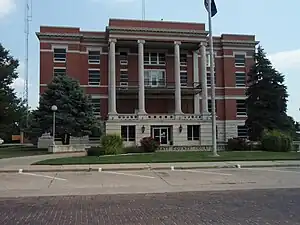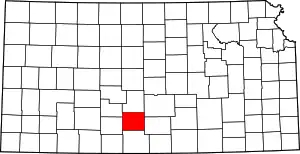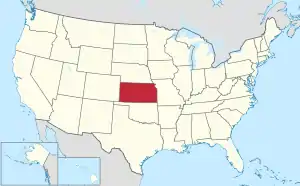Pratt County | |
|---|---|
 Pratt County Courthouse in Pratt (2009) | |
 Location within the U.S. state of Kansas | |
 Kansas's location within the U.S. | |
| Coordinates: 37°39′24″N 98°44′24″W / 37.6567°N 98.74°W | |
| Country | |
| State | |
| Founded | February 26, 1867 |
| Named for | Caleb S. Pratt[1] |
| Seat | Pratt |
| Largest city | Pratt |
| Area | |
| • Total | 736 sq mi (1,910 km2) |
| • Land | 735 sq mi (1,900 km2) |
| • Water | 0.7 sq mi (2 km2) 0.09% |
| Population | |
| • Total | 9,157 |
| • Density | 12.5/sq mi (4.8/km2) |
| Time zone | UTC−6 (Central) |
| • Summer (DST) | UTC−5 (CDT) |
| Congressional district | 4th |
| Website | PrattCounty.org |
Pratt County is a county located in the U.S. state of Kansas. Its county seat and largest city is Pratt.[3] As of the 2020 census, the county population was 9,157.[2] The county was named for Caleb Pratt, a primary person involved in Bleeding Kansas and died at the Battle of Wilson's Creek during the American Civil War.
History
Early history
For many millennia, the Great Plains of North America was inhabited by nomadic Native Americans. From the 16th century to 18th century, the Kingdom of France claimed ownership of large parts of North America. In 1762, after the French and Indian War, France secretly ceded New France to Spain, per the Treaty of Fontainebleau.
19th century
In 1802, Spain returned most of the land to France, but keeping title to about 7,500 square miles. In 1803, most of the land for modern day Kansas was acquired by the United States from France as part of the 828,000 square mile Louisiana Purchase for 2.83 cents per acre.
In 1854, the Kansas Territory was organized, then in 1861 Kansas became the 34th U.S. state. In 1867, Pratt County was established.
In 1887, the Chicago, Kansas and Nebraska Railway extended its main line from Herington to Pratt.[4] This main line connected Herington, Ramona, Tampa, Durham, Waldeck, Canton, Galva, McPherson, Groveland, Inman, Medora, Hutchinson, Whiteside, Partridge, Arlington, Langdon, Turon, Preston, Natrona, Pratt. In 1888, this main line was extended to Liberal. Later, this line was extended to Tucumcari, New Mexico and El Paso, Texas. This line is called the "Golden State Limited".
Geography
According to the U.S. Census Bureau, the county has a total area of 736 square miles (1,910 km2), of which 735 square miles (1,900 km2) is land and 0.7 square miles (1.8 km2) (0.09%) is water.[5]
Adjacent counties
- Stafford County (north)
- Reno County (northeast)
- Kingman County (east)
- Barber County (south)
- Kiowa County (west)
- Edwards County (northwest)
Demographics

| Census | Pop. | Note | %± |
|---|---|---|---|
| 1880 | 1,890 | — | |
| 1890 | 8,118 | 329.5% | |
| 1900 | 7,085 | −12.7% | |
| 1910 | 11,156 | 57.5% | |
| 1920 | 12,909 | 15.7% | |
| 1930 | 13,312 | 3.1% | |
| 1940 | 12,348 | −7.2% | |
| 1950 | 12,156 | −1.6% | |
| 1960 | 12,122 | −0.3% | |
| 1970 | 10,056 | −17.0% | |
| 1980 | 10,275 | 2.2% | |
| 1990 | 9,702 | −5.6% | |
| 2000 | 9,647 | −0.6% | |
| 2010 | 9,656 | 0.1% | |
| 2020 | 9,157 | −5.2% | |
| U.S. Decennial Census[6] 1790-1960[7] 1900-1990[8] 1990-2000[9] 2010-2020[2] | |||
As of the census[10] of 2000, there were 9,647 people, 3,963 households, and 2,639 families residing in the county. The population density was 13 people per square mile (5.0 people/km2). There were 4,633 housing units at an average density of 6 per square mile (2.3/km2). The racial makeup of the county was 95.28% White, 0.98% Black or African American, 0.35% Native American, 0.55% Asian, 0.03% Pacific Islander, 1.73% from other races, and 1.07% from two or more races. 3.09% of the population were Hispanic or Latino of any race.
There were 3,963 households, out of which 30.00% had children under the age of 18 living with them, 56.70% were married couples living together, 7.50% had a female householder with no husband present, and 33.40% were non-families. 30.40% of all households were made up of individuals, and 14.60% had someone living alone who was 65 years of age or older. The average household size was 2.35 and the average family size was 2.93.
In the county, the population was spread out, with 24.50% under the age of 18, 9.40% from 18 to 24, 24.00% from 25 to 44, 22.80% from 45 to 64, and 19.20% who were 65 years of age or older. The median age was 40 years. For every 100 females there were 94.00 males. For every 100 females age 18 and over, there were 91.30 males.
The median income for a household in the county was $35,529, and the median income for a family was $43,156. Males had a median income of $31,138 versus $20,679 for females. The per capita income for the county was $17,906. About 6.70% of families and 9.40% of the population were below the poverty line, including 11.50% of those under age 18 and 8.90% of those age 65 or over.
Government
Presidential elections
| Year | Republican | Democratic | Third party | |||
|---|---|---|---|---|---|---|
| No. | % | No. | % | No. | % | |
| 2020 | 3,108 | 75.13% | 933 | 22.55% | 96 | 2.32% |
| 2016 | 2,838 | 73.87% | 771 | 20.07% | 233 | 6.06% |
| 2012 | 2,771 | 72.90% | 980 | 25.78% | 50 | 1.32% |
| 2008 | 2,822 | 67.35% | 1,294 | 30.88% | 74 | 1.77% |
| 2004 | 3,121 | 71.19% | 1,200 | 27.37% | 63 | 1.44% |
| 2000 | 2,885 | 65.33% | 1,314 | 29.76% | 217 | 4.91% |
| 1996 | 2,591 | 58.87% | 1,367 | 31.06% | 443 | 10.07% |
| 1992 | 1,779 | 37.17% | 1,466 | 30.63% | 1,541 | 32.20% |
| 1988 | 2,505 | 59.01% | 1,651 | 38.89% | 89 | 2.10% |
| 1984 | 3,244 | 71.31% | 1,255 | 27.59% | 50 | 1.10% |
| 1980 | 2,866 | 61.20% | 1,369 | 29.23% | 448 | 9.57% |
| 1976 | 2,427 | 50.04% | 2,307 | 47.57% | 116 | 2.39% |
| 1972 | 3,253 | 71.20% | 1,214 | 26.57% | 102 | 2.23% |
| 1968 | 2,670 | 57.91% | 1,490 | 32.31% | 451 | 9.78% |
| 1964 | 2,493 | 48.61% | 2,594 | 50.58% | 42 | 0.82% |
| 1960 | 3,501 | 63.59% | 1,968 | 35.74% | 37 | 0.67% |
| 1956 | 3,620 | 64.53% | 1,956 | 34.87% | 34 | 0.61% |
| 1952 | 3,998 | 68.87% | 1,743 | 30.03% | 64 | 1.10% |
| 1948 | 2,878 | 50.22% | 2,751 | 48.00% | 102 | 1.78% |
| 1944 | 2,658 | 52.85% | 2,334 | 46.41% | 37 | 0.74% |
| 1940 | 2,930 | 49.94% | 2,870 | 48.92% | 67 | 1.14% |
| 1936 | 1,946 | 33.40% | 3,871 | 66.43% | 10 | 0.17% |
| 1932 | 2,167 | 40.15% | 3,109 | 57.61% | 121 | 2.24% |
| 1928 | 4,055 | 80.58% | 934 | 18.56% | 43 | 0.85% |
| 1924 | 2,762 | 57.36% | 1,205 | 25.03% | 848 | 17.61% |
| 1920 | 2,722 | 64.15% | 1,433 | 33.77% | 88 | 2.07% |
| 1916 | 1,820 | 37.93% | 2,607 | 54.34% | 371 | 7.73% |
| 1912 | 372 | 15.05% | 947 | 38.32% | 1,152 | 46.62% |
| 1908 | 1,193 | 50.53% | 1,027 | 43.50% | 141 | 5.97% |
| 1904 | 1,076 | 63.44% | 421 | 24.82% | 199 | 11.73% |
| 1900 | 821 | 49.04% | 816 | 48.75% | 37 | 2.21% |
| 1896 | 621 | 42.71% | 820 | 56.40% | 13 | 0.89% |
| 1892 | 947 | 44.19% | 0 | 0.00% | 1,196 | 55.81% |
| 1888 | 1,115 | 50.18% | 652 | 29.34% | 455 | 20.48% |
Laws
Following amendment to the Kansas Constitution in 1986, Pratt County remained a prohibition, or "dry", county until 2000, when voters approved the sale of alcoholic liquor by the individual drink with a 30 percent food sales requirement.[12]
Education
Colleges
Unified school districts
Communities

Cities
Unincorporated communities
Townships
Pratt County is divided into seven townships. The city of Pratt is considered governmentally independent and is excluded from the census figures for the townships. In the following table, the population center is the largest city (or cities) included in that township's population total, if it is of a significant size.
| Township | FIPS | Population center |
Population | Population density /km2 (/sq mi) |
Land area km2 (sq mi) | Water area km2 (sq mi) | Water % | Geographic coordinates |
|---|---|---|---|---|---|---|---|---|
| Township No. 6 | 71223 | 565 | 1 (4) | 381 (147) | 1 (0) | 0.17% | 37°44′25″N 98°33′55″W / 37.74028°N 98.56528°W | |
| Township No. 7 | 71228 | 366 | 3 (7) | 136 (52) | 0 (0) | 0.02% | 37°45′20″N 98°43′49″W / 37.75556°N 98.73028°W | |
| Township No. 8 | 71233 | 181 | 1 (2) | 197 (76) | 0 (0) | 0% | 37°47′3″N 98°53′42″W / 37.78417°N 98.89500°W | |
| Township No. 9 | 71238 | 317 | 1 (2) | 379 (146) | 0 (0) | 0.05% | 37°37′59″N 98°54′7″W / 37.63306°N 98.90194°W | |
| Township No. 10 | 71242 | 191 | 1 (3) | 188 (73) | 0 (0) | 0.01% | 37°30′45″N 98°52′17″W / 37.51250°N 98.87139°W | |
| Township No. 11 | 71245 | 496 | 2 (5) | 281 (109) | 0 (0) | 0.06% | 37°30′44″N 98°38′21″W / 37.51222°N 98.63917°W | |
| Township No. 12 | 71248 | 961 | 3 (8) | 321 (124) | 1 (0) | 0.19% | 37°37′44″N 98°40′52″W / 37.62889°N 98.68111°W |
See also
- Community information for Kansas
References
- ↑ "Pratt, Kansas History". Kansas Community Networks. Retrieved November 4, 2012.
- 1 2 3 "QuickFacts; Pratt County, Kansas; Population, Census, 2020 & 2010". United States Census Bureau. Archived from the original on August 19, 2021. Retrieved August 19, 2021.
- ↑ "Find a County". National Association of Counties. Retrieved June 7, 2011.
- ↑ "Rock Island's Family Tree - Page 4". home.covad.net. Archived from the original on June 19, 2011. Retrieved April 18, 2011.
- ↑ "US Gazetteer files: 2010, 2000, and 1990". United States Census Bureau. February 12, 2011. Retrieved April 23, 2011.
- ↑ "U.S. Decennial Census". United States Census Bureau. Retrieved July 28, 2014.
- ↑ "Historical Census Browser". University of Virginia Library. Retrieved July 28, 2014.
- ↑ "Population of Counties by Decennial Census: 1900 to 1990". United States Census Bureau. Retrieved July 28, 2014.
- ↑ "Census 2000 PHC-T-4. Ranking Tables for Counties: 1990 and 2000" (PDF). United States Census Bureau. Archived (PDF) from the original on March 27, 2010. Retrieved July 28, 2014.
- ↑ "U.S. Census website". United States Census Bureau. Retrieved January 31, 2008.
- ↑ Leip, David. "Dave Leip's Atlas of U.S. Presidential Elections". uselectionatlas.org.
- ↑ "Map of Wet and Dry Counties". Alcoholic Beverage Control, Kansas Department of Revenue. November 2006. Archived from the original on October 8, 2007. Retrieved December 26, 2007.
- Notes
Further reading
- Standard Atlas of Pratt County, Kansas; Geo. A. Ogle & Co; 67 pages; 1922.
- Standard Atlas of Pratt County, Kansas; Geo. A. Ogle & Co; 54 pages; 1906.
External links
- County
- Maps